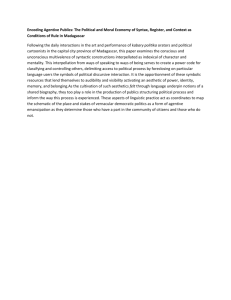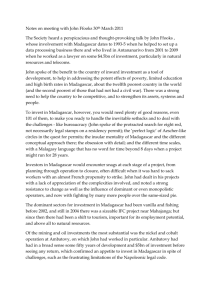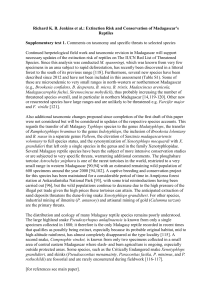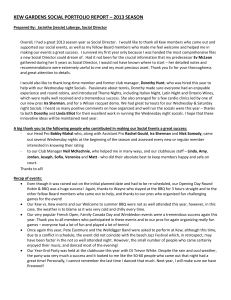KEW PUBLISHING - Royal Botanic Gardens, Kew
advertisement
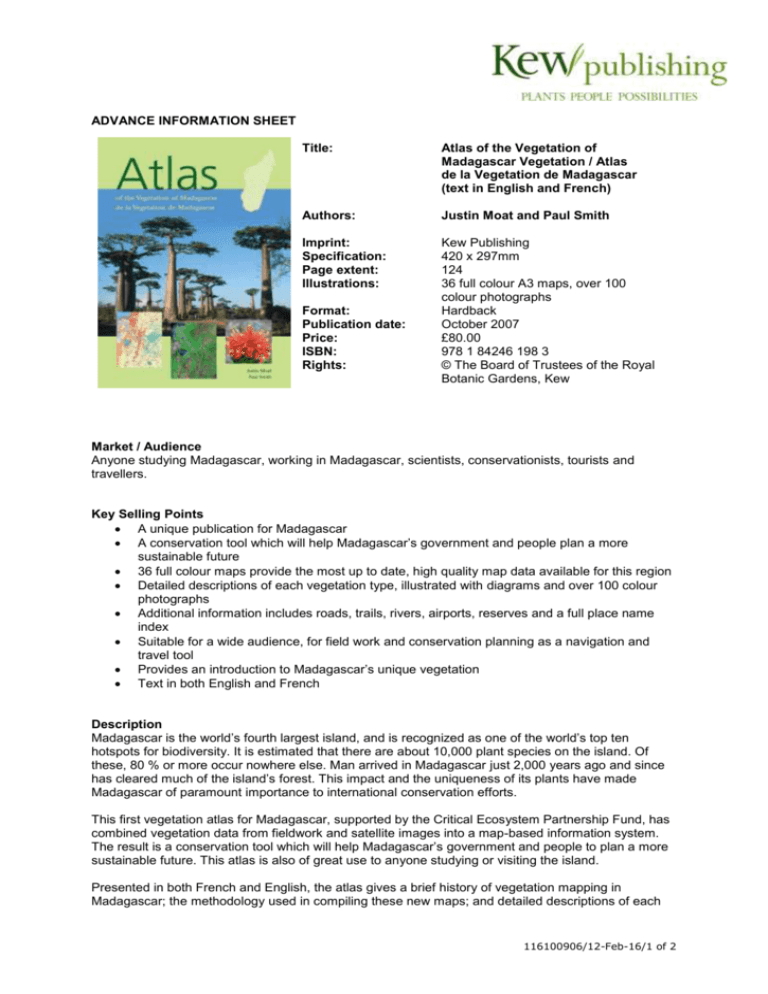
ADVANCE INFORMATION SHEET Title: Atlas of the Vegetation of Madagascar Vegetation / Atlas de la Vegetation de Madagascar (text in English and French) Authors: Justin Moat and Paul Smith Imprint: Specification: Page extent: Illustrations: Kew Publishing 420 x 297mm 124 36 full colour A3 maps, over 100 colour photographs Hardback October 2007 £80.00 978 1 84246 198 3 © The Board of Trustees of the Royal Botanic Gardens, Kew Format: Publication date: Price: ISBN: Rights: Market / Audience Anyone studying Madagascar, working in Madagascar, scientists, conservationists, tourists and travellers. Key Selling Points A unique publication for Madagascar A conservation tool which will help Madagascar’s government and people plan a more sustainable future 36 full colour maps provide the most up to date, high quality map data available for this region Detailed descriptions of each vegetation type, illustrated with diagrams and over 100 colour photographs Additional information includes roads, trails, rivers, airports, reserves and a full place name index Suitable for a wide audience, for field work and conservation planning as a navigation and travel tool Provides an introduction to Madagascar’s unique vegetation Text in both English and French Description Madagascar is the world’s fourth largest island, and is recognized as one of the world’s top ten hotspots for biodiversity. It is estimated that there are about 10,000 plant species on the island. Of these, 80 % or more occur nowhere else. Man arrived in Madagascar just 2,000 years ago and since has cleared much of the island’s forest. This impact and the uniqueness of its plants have made Madagascar of paramount importance to international conservation efforts. This first vegetation atlas for Madagascar, supported by the Critical Ecosystem Partnership Fund, has combined vegetation data from fieldwork and satellite images into a map-based information system. The result is a conservation tool which will help Madagascar’s government and people to plan a more sustainable future. This atlas is also of great use to anyone studying or visiting the island. Presented in both French and English, the atlas gives a brief history of vegetation mapping in Madagascar; the methodology used in compiling these new maps; and detailed descriptions of each 116100906/12-Feb-16/1 of 2 vegetation type, illustrated with photographs and diagrams. Trends in deforestation, extent of occurrence and levels of protection are assessed for each vegetation type. Additional information includes roads, trails, rivers, airports, reserves and a full place name index. The atlas comprises 36 maps in A3 format, all in high resolution colour. Author information For 15 years Justin Moat has been employed at The Royal Botanic Gardens, Kew with the initial remit of setting up a GIS unit, which he currently heads. After completing his masters on mapping Madagascar’s vegetation, he continues to take every opportunity to work on this unique island. Paul Smith is an ecologist with practical experience in vegetation mapping, botanical inventory and survey, impact assessment, park management systems and ecotourism. He has a wide and detailed knowledge of the plants of southern, central and east Africa, and has twenty years experience working in Africa and Madagascar. Paul is Head of the Seed Conservation Department at Kew and leader of the Millennium Seed Bank Project. Sales and distribution For trade sales enquiries please contact John Harris or Lydia White: John Harris Tel: +44 (0)20 8332 5776 Fax: +44 (0)20 8332 5646 Email: j.harris@kew.org Lydia White Tel: +44 (0)20 8332 5751 Fax: +44 (0)20 8332 5646 Email: l.white@kew.org To place an order, please contact: Steve Dodman Publication Sales, Kew Publishing, Sir Joseph Banks Building, Royal Botanic Gardens, Kew, Richmond, Surrey TW9 3AE, UK Tel: +44 (0)20 8332 5219 Fax: +44 (0)20 8332 5646 email kewbooks@kew.org Find out more at www.kewbooks.com and to learn more about Kew visit www.kew.org 116100906/12-Feb-16/2 of 2
